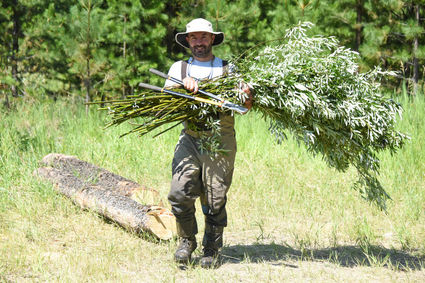Volunteers contribute to Fishtrap Creek project
August 13, 2020

Northwestern Energy photo
VOLUNTEERING IN THE WILD - Marc Terrazas with Montana Fish, Wildlife and Parks brings freshly cut willows to a staging area to be bundled. Willow stems were collected from a large beaver meadow along Fishtrap Creek.
A small group of volunteers helped restore wetland habitats and increase wildlife access to Fishtrap Creek last week. The efforts of volunteers contributed to the West Fork Fishtrap Creek Road Realignment Project, which relocated the junction of West Fork Fishtrap Creek Road (NFSR 7609) with Fishtrap Creek Road (NFSR 516), approximately 600 feet to the north.
"This will reduce sediment entering the stream and allow for the creation of enhanced stream and wetland habitat along mainstream Fishtrap Creek, benefitting coldwater trout species, including westslope cutthroat trout and bull trout," a Plains press release stated about the project.
The multiple projects for habitat restoration in the Fishtrap Creek area, were implemented through the partnership between the Lolo National Forest, Lower Clark Fork Watershed Group, Yellowstone to Yukon Conservation Initiative, Trout Creek Unlimited and Montana Fish, Wildlife and Parks. Elk Creek Contracting, Traver's Excavator Service, and Milner Brothers Logging were the three local contractors hired to work on these projects.
Under the guidance of the Lower Clark Fork Watershed, a small group of volunteers, with the help of some extra project partners, assisted in the collection of around 2,400 willow stem cuttings. "The primary motivation for the project is to protect the fish habitat on the river," Brita Olson, Lower Clark Fork Watershed Group Coordinator, said. "By building a road right next to the river, it can disrupt some of the normal processes that create and maintain the habitat."
When you have a road located right next to the river, there will be no shrubs or trees growing alongside the streambed, which will create its own biological implications, according to Olson. "Let's say you have a shrub that is hanging over the river. Not only does that shade the river, provide some cover for the fish in the stream, it has roots that hold the bank intact. Not to mention, all the bugs that hang out on a willow plant that can fall into the river, those are all important inputs that go into a stream that help maintain a food chain in the stream system," Olson said. "However, if you have a road, you won't have any tree cover and no biological benefits are provided."
When explaining what will be happening to the current road, Olson said, "In realigning the Fishtrap Creek Road away from the stream, we are moving the junction of the road. It's a "Y" shape junction, which is common on forest service roads. There are 600 to 700 feet of parallel roads because of this "Y" shape, so, we are getting rid of one side of the "Y," and building a "T" junction further up. There will be more 90-degree angles, which will reduce the amount of road right next to the stream."
Another crucial, biological benefit that is important for having a diverse habitat in the stream, Olson said, is having wood from trees alongside the riverbed, fall into the stream. This will create pools, allowing for more diverse features in the river that are beneficial for fish habitats.
"A lot of the time we only talk about fish, but most species of wildlife in Montana rely on healthy riparian areas for their habitat," Olson said. "When you improve riparian fish habitats, it has a lot of intersecting benefits for all sorts of wildlife species, and it's just part of maintaining an overall, healthy system for the river, and maintaining a healthy watershed."
The willow stems to help hold the newly built riverbed intact were collected upstream from the project from a willow grove. "Willows are a great source of native material because they are an adapted species and have evolved alongside the beaver," Olson stated. "We only take one third of the plant. We take the stems from around the base, which will stimulate the plant to grow more. You're not depleting the area you are taking it from."
The following week the willow cuttings were set to be embedded in the floodplain where the road was removed. Aside from some additional plantings that will need to be done in the fall, and monitoring the growth in the spring, Olson said she considers the project a success. "There were a lot of moving parts, but it was good to get it all done. It was good getting everyone out there to get the project done as well."






Reader Comments(0)